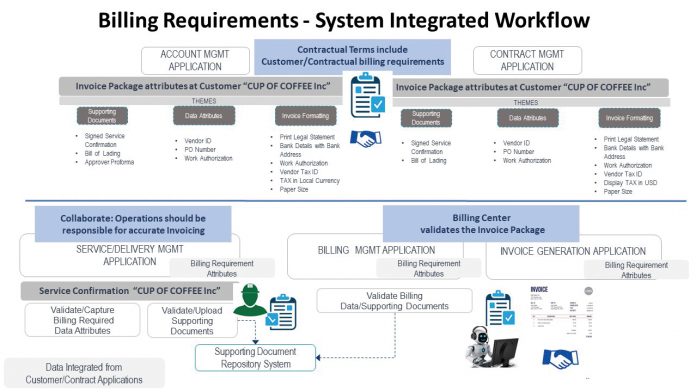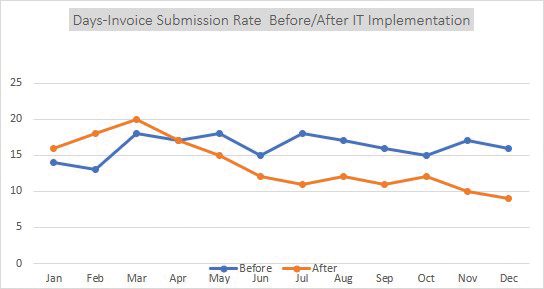
Meet the Demand to Improve Liquidity with Seamless Invoicing
If you were to pick the singular, culture-defining moment that transformed the business environment in the decades bracketing the turn of the millennium, you would have to choose technology for the many ways it streamlined operational processes.
Two decades later, we are again at the threshold of seismic shifts in process management, as evolving robotic process automation (RPA) tools that help organizations create value are changing how global businesses operate in energy and other sectors.

In my 25 years working in the oilfield services industry, I have witnessed the adaptation of new technology systems, from mainframe architecture to today’s emerging and nimble value creation technologies. While information technology (IT) solutions of the early 90s drove efficiency to the end-user at the transaction level, today’s IT strategies are being designed to meet the increasing demand for process efficiency and value creation. Throughout energy, manufacturing, and other industries, we see that the stakeholders’ mindset has changed, driving objectives for process optimization and early value creation.
These new tools enable enterprise teams to align software and processes to maximize organizational value. But even the best tools are still only tools — they depend upon human buy-in to work effectively. With acceptance and collaboration, new RPA systems can enable us to design a path in which the contracts management, service delivery and billing teams can work together to improve efficiency and help any company get paid faster.
Seamless Invoicing matters
A company’s liquidity is a key factor driving financial growth and future investments. One of the easiest ways to improve liquidity and increase free cash flow is to submit accurate invoices to your customers early in your revenue cycle process.
For any business, the key takeaways in terms of invoice submission are timing and accuracy. In a cost-saving environment such as the energy industry, where market pressures necessitate even more stringent operations, the procurement side of oil and gas companies demands that every invoice be audited prior to payment. Because invoice auditing by the customer delays approval and settlement, creating a long cycle in which cash flow is hindered, oilfield services companies must ensure that they are sending accurate invoices promptly in order to maintain their own liquidity.
David Yager sums up the problem in his article, “The Broken Payment Model that Costs the Oil Industry Millions.” Regarding the invoice, Yager says: “Once it has been exhaustively reviewed to ensure every i is dotted and t is crossed (it has to be perfect to ensure final payment), the invoice is sent to the client’s head office.” But all that i-dotting and t-crossing takes time, and time is money. How much money?
“Invoicing delays kill your cash flow,” says one developer of oilfield services enterprise resource planning software. “For example, invoicing just 10 days faster results in a $273,972 increase in cash flow for every $10,000,000 in annual sales.”
In most oilfield service companies, the fundamental causes of invoicing delays can be found within the organization, and the root cause can often be attributed to a lack of departmental collaboration and IT solutions that enable faster invoicing. This is exacerbated when invoicing processes are centralized or outsourced. Most of the delays could have been easily avoided by simply following the customers’ billing requirements.
Using process alignment and digital solutions to improve the invoicing submission rate
The path to speeding up invoice submission requires alignment among personnel and systems in contracts management, service delivery and billing. The following steps, in conjunction with a well-designed IT solution, will guide a process that reduces errors and accelerates cash flow.
Step 1: Contractual terms should include billing requirements.
The more people involved in setting the deal, the bigger the chance that this information gets lost. Sales representatives are often the people who receive the billing instructions, but as they direct their focus to securing new leads, they may neglect the formalities that come after winning a client or project. Tighten your process with these steps:
Include specifications and written agreements about the billing requirements in the account management/contract lifecycle process.
Your customer/contract management IT solution should facilitate the governance and capture of billing requirements: this data forms the digital repository of billing requirements, which specifies the operational data, supporting documents and invoice format agreed upon for submission as part of the billing process.
Improve contract data visibility: leverage your contract data for insight into projected billings, projected revenue, billing and contract renewal status; and store and manage all information about customer agreements in a single location.
Step 2: Operations should be responsible for accurate invoicing.
The primary focus of the operations department is on service/product delivery, yet this is where most of the billing requirements in the form of documentation and data will be collected. Because of their operational focus, field engineers often fail to capture essential information, including the correct customer name, bill-to address, lease/well number, AFE/PO number, contact number, and/or the name of the company representative. Missing billing information slows down the invoice process or can even lead to disputed invoices, which further delay invoice approval and payment. You can prevent these problems in the following ways:
The standard work instructions (SWI) for operations should include the collection of supporting documents and the capture of data to support billing requirements.
Your Field Ticketing IT solution should integrate with the digital repository (accounts/contracts IT solution) of billing requirements and build validation to ensure that documents and data to support invoicing are collected on time.
To eliminate human error, design and require the use of standard forms to capture information at the well site.
Step 3: The billing team validates the invoice package.
Billing teams must be aware of all required documents and data before an invoice is submitted, and this checklist should be maintained in digital form. However, each item on the checklist needs to be manually validated, which — because it is prone to human error — can cause delays in generating and submitting the invoice. You can minimize errors and delays and better protect your data by:
Defining a responsibility assignment matrix (RACI: Responsible, Accountable, Consulted, Informed) to manage the E2E (end to end) process, so that the billing team knows who is internally responsible for changes to the billing requirements and who is collecting the documents and data.
Implementing system-enforced business rules to validate your invoice package before submission.
Integrating seamless invoice output generation software with the digital repository (accounts/contracts IT solution) of billing requirements to ensure invoice formats are compliant with local regulations.
Using RPA tools to automate some of the manual repetitive validations.
Adopting eCommerce standards as recommended by OFS Portal®, a member-based advocacy community comprised of upstream oilfield service companies and oil and gas companies to promote data security in the oil and gas sector. OFS Portal champions the use of Petroleum Industry Data Exchange (PIDX International) standards in upstream eCommerce exchanges such as billing.
An integrated IT solution
This illustration of a system-integrated workflow depicts an IT solution that enables collaboration between the departmental teams, to ensure clarity, compilation, and validation of the billing requirements.
Step 4: Monitor, measure, improve.
Currently, although we spend days looking at invoice issues, there is no collaborative way to review what is going well and what is not. The process outlined in the illustration above provides a way to implement solutions and then track and measure them to gauge whether they are working and determine how we can do better. For example:
If we identify various billing requirements for the same customer, perhaps they could be negotiated with the customer to create uniform requirements that simplify the process.
We can identify which key elements of the invoice package take longer to generate and collect.
We can measure the effectiveness of our collaboration with various stakeholders, including teams in sales, operations, and the billing center to determine who is causing the delay and how it can be improved, and then take steps to develop and implement training and change management.
Value Creations
The time you invest in focusing on process alignment and implementing an agile IT solution will yield significant financial results over time. As this graph shows, a collaborative process combined with an RPA solution decreased the number of days it took to generate an invoice, thereby producing a significant improvement in the invoice submission rate after the IT solution was implemented.
Integrating contract management solutions with service ticket solutions ensures the timely collection of documents and data, and RPA tools eliminate human error in validating the final invoice. Today’s robust customer portal tools also make it possible to implement additional E2E billing integration with oilfield services companies, for a seamless invoicing solution that will have a positive impact on the bottom line.
About the author: Dinesh Vaz specializes in information technology process management, with 25 years of expertise in the design, creation, testing, training, and cross-departmental implementation of transformative business system applications for the oil and gas industry. As an Operating System Process Owner at Schlumberger, Mr. Vaz is an Advance Scoping Champion on an elite team empowered to work with the oilfield services company’s global business units preparing for SAP deployment, and responsible for overseeing the worldwide launch of new digital tools and systems.
Meet the Demand to Improve Liquidity with Seamless Invoicing














